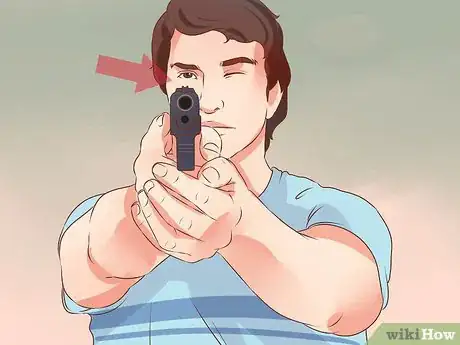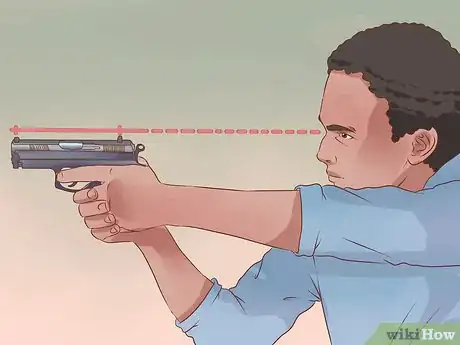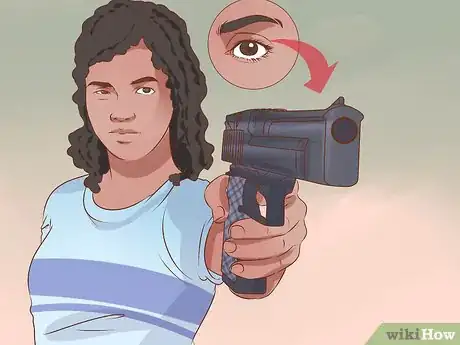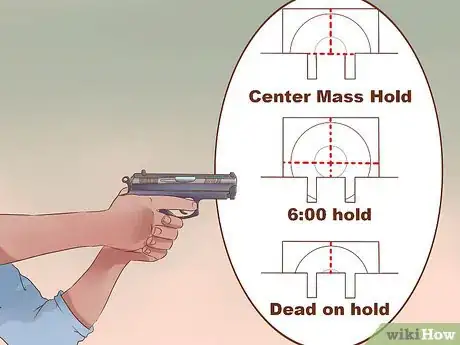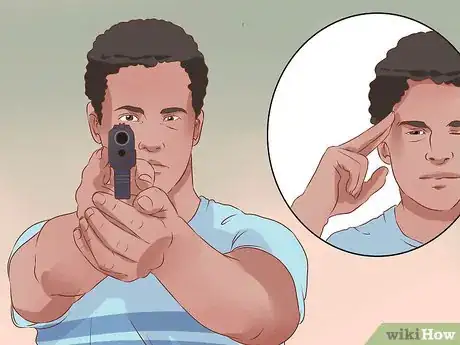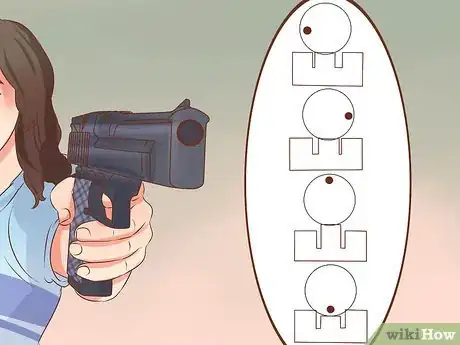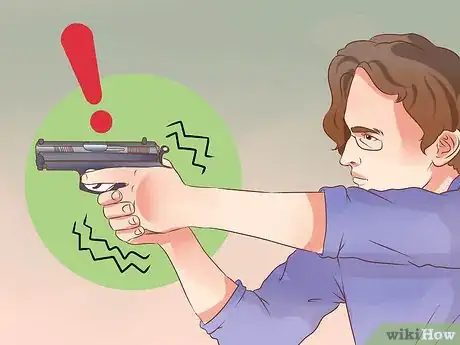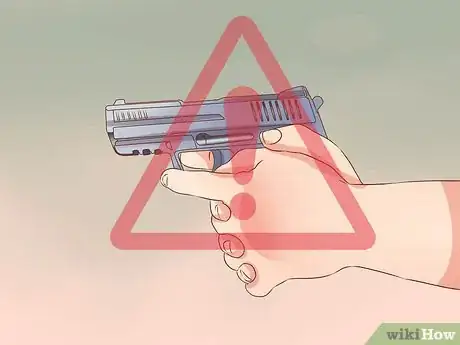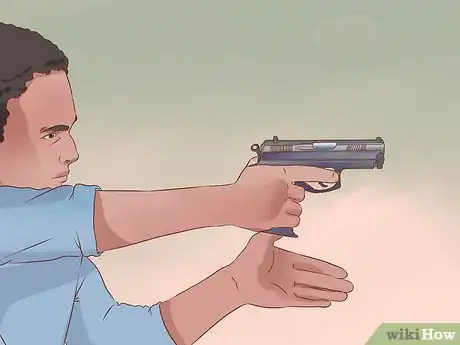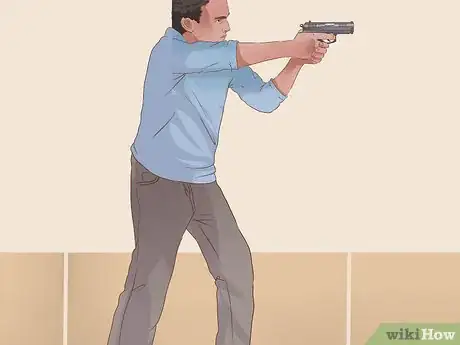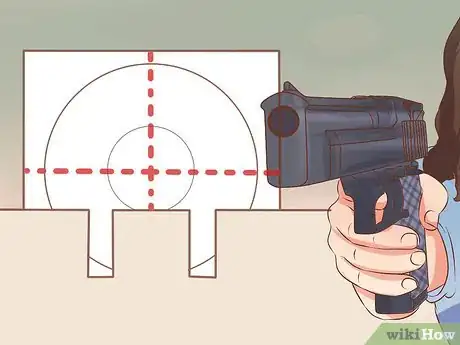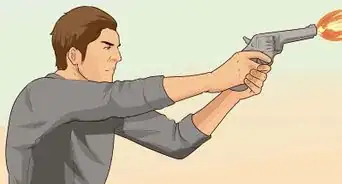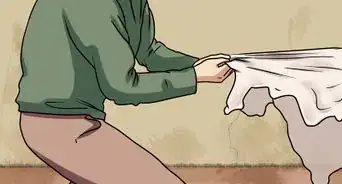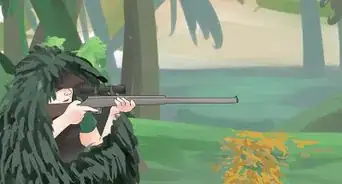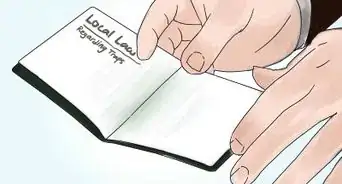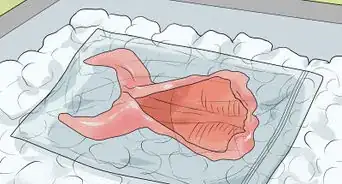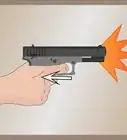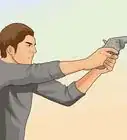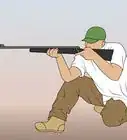wikiHow is a “wiki,” similar to Wikipedia, which means that many of our articles are co-written by multiple authors. To create this article, 9 people, some anonymous, worked to edit and improve it over time.
There are 14 references cited in this article, which can be found at the bottom of the page.
wikiHow marks an article as reader-approved once it receives enough positive feedback. This article received 20 testimonials and 90% of readers who voted found it helpful, earning it our reader-approved status.
This article has been viewed 779,016 times.
Learn more...
If you've never shot a gun before, it's not necessarily a bad idea to know how to do so the right way. Aiming a pistol is fairly easy, in theory, but it will probably take practice and experience before aiming correctly becomes second nature. When you do take a trip to a gun range, here's what you need to do to aim a pistol correctly.
Things You Should Know
- Use your dominant eye to aim while keeping the front and back sights of your pistol aligned.
- Avoid moving your hands while you shoot.
- Watch for grip and handling errors by monitoring how your bullet shoots.
- Hold your gun with both hands, stand in the extended shooting position, and aim carefully.
Steps
Aiming Essentials
-
1Aim with your dominant eye. Aiming with both eyes is next to impossible, so you need to take aim with your dominant eye. Your dominant eye presents a more accurate picture of your surroundings than your non-dominant eye.
- Your dominant eye is usually lines up with your dominant hand, but this is not always the case.
- To determine which eye is your dominant one, form a 1-inch (2.5-cm) circle with your thumb and index finger. Hold the circle at arm's length and look through it to a distant object.[1]
- Gradually bring the circle toward your face with both eyes open, but do not look at it. You hand will naturally move toward your dominant eye.
-
2Align the front and back sights. A pistol has a rear sight and a front sight. When aiming the gun, the post of the front sight should be evenly centered in between the two posts of the rear sight.[2]
- The front sight consists of a single post and the back sight consists of two posts.
- There needs to be an equal amount of space to the left and the right of the front sight.
- The top of the front sight should also be flush or even with the tops of the back sight posts.
Advertisement -
3Focus your eyes on the gun. As you aim the pistol, you will need to look at the rear sight, front sight, and the target. It is physically impossible for your eyes to focus on all three objects at once, though. In order to aim the gun properly, you need to make sure that your eyes are focused on the gun sights and not the target.[3]
- The target should look a little blurry. You should still be able to see it, but it should fall to the background and look much less crisp than the gun sights appear.
- More specifically, you should be focusing on your front sight. The front sight lets you know what your gun's relative position to the target is.
-
4Choose your point of aim. There are three acceptable points of aim. No single option is officially better than the others, so you'll need to test them each out to determine which works best for you.[4]
- For the center hold or center of mass aim, place the top of the front sight at the center of the target. The top should run through the horizontal center of the target.
- For the 6 o'clock aim, place the top of the front sight just below the bullseye area. If using an actual shooting target, the top of the front sight will overlap the bottom of the black bullseye.
- For the sub-6 aim, you will need to place the top of the front sight even further below the bullseye area. When using actual shooting targets, the top of the sight will be roughly in the middle of the white portion below the black bullseye area.
-
5Concentrate. Aiming a pistol requires patience and concentration. Sloppy aim will result in a sloppy shot.
- Before firing the pistol, make sure your shots are correctly aligned.
- Be patient when pressing the trigger. If you feel anxious about firing the gun and concentrate on applying more pressure to the trigger, even for a moment, you will lose concentration on your aim and will probably have a poor shot.
Common Mistakes
-
1Identify angular shift errors. An angular shift error occurs when the sights are not properly aligned.[5] You can usually determine if you are making a consistent angular error based on the placement of your bullet in the target.[6]
- If the bullet hits below the center of the target, the top of the front sight may have shifted below the tops of the back sight posts.
- If the bullet hits above the center of the target, the top of the front sight may have shifted above the tops of the back sight posts.
- If the bullet hits right of center, the front sight might be closer to the right side of the back sight.
- If the bullet hits left of center, the front sight might be closer to the left side of the back sight.
-
2Pick out a parallel shift error.[7] Parallel shift errors occur when your sights are properly aligned, but your hand moves as you fire. Holding the pistol still results in the most accurate shot, but typically, parallel shift errors do not disrupt your aim as much as angular shift errors do.
- Parallel shift errors almost always result from your wrist either breaking up or breaking down, so the placement of your shot will usually be either just above center or just below it, respectively.
-
3Spot grip and handling errors. Shift errors are not the only problems you might encounter. The placement of your bullet in the target could also indicate a handful of other problems.[8]
- If the bullet hits out of center and closer to your dominant side, you could be squeezing your thumb or using too much trigger finger. Similarly, if it falls to the other side of the center, you might be using too little trigger finger.
- If it falls to the lower right for right-handed shooters, or vice versa for left-handed shooters, you could be tightening your grip while pulling the trigger. If it falls to the lower left, you could be tightening your fingers or jerking the trigger.
- If the bullet lands to the upper right for right-handed shooters, or vice versa for left-handed shooters, you might be anticipating recoil in your shot. If it goes to the upper left, you might be anticipating recoil or lacking follow through.
Putting It All Together
-
1Grip the gun on the back strap with your dominant hand. Your dominant hand should be placed high along the back strap—the back of your pistol's grip—with your thumb to the inside of the barrel.[9]
- Your middle, ring, and pinky fingers should wrap around the outside and front of the grip.
- Your index finger should rest against the outside of the trigger guard.[10]
- This position give you the maximum amount of leverage against the gun. When you fire the pistol, it will recoil, and good leverage is an important part of keeping your hand steady.
-
2Place your non-dominant hand against the exposed grip. Your non-dominant hand is your support hand, and the way you position this hand will add further support and leverage against the recoil of your firing pistol.[11]
- Place the support hand as high as possible around the grip.
- All four fingers should be under the trigger guard, and the index finger should press the bottom outside of the guard firmly.[12]
- The thumb should point forward and meet with your other thumb on the opposite side of the gun.
-
3Take the extended shooting position. Stand with your feet planted firmly on the ground and pointed in the direction of your target. Your feet should be shoulder width apart, and your knees should be slightly bent.
- This stance makes it easy to move yet provides you with stability.
- Grab your pistol and raise it up until it is positioned in front of you. Your arms should be straight out and slightly bent at the elbows, and the gun should be nowhere near your face.
-
4Aim the pistol. Follow the instructions provided in this article to aim the pistol at your target properly.
-
5Press the trigger until the pistol fires. Instead of "pulling" the trigger, you need to press or squeeze the trigger in a controlled fashion.[13]
- Press the trigger straight to the rear using a constant pressure. Only use pressure on the front of the trigger and not on the sides.
- Squeeze the trigger until you start feeling resistance to take the slack out of it.
- Continue pressing the trigger in this manner until the pistol shoots. Try not to anticipate when this will happen, since doing so often leads to a last-minute error in aim.
Community Q&A
-
QuestionWould my shot be less accurate if I hold it sideways with my palm facing down?
 Community AnswerYes it would be, also if you're going to do it that way, you're likely to seriously hurt your face and/or your hand because of the recoil.
Community AnswerYes it would be, also if you're going to do it that way, you're likely to seriously hurt your face and/or your hand because of the recoil. -
QuestionHow do I reduce blinking when shooting?
 Community AnswerIt depends on what you mean by "blinking." If you mean "wincing" because you are anticipating the discharge, you just have to shoot enough that you stop being afraid of it. It may also help to practice with a lower-caliber firearm until you get over it. Wincing aside, some people blink more when they're nervous or trying to concentrate. Again, I think the solution is to shoot more until it feels natural.
Community AnswerIt depends on what you mean by "blinking." If you mean "wincing" because you are anticipating the discharge, you just have to shoot enough that you stop being afraid of it. It may also help to practice with a lower-caliber firearm until you get over it. Wincing aside, some people blink more when they're nervous or trying to concentrate. Again, I think the solution is to shoot more until it feels natural. -
QuestionI'm left eye dominant but right-handed. Should I learn to shoot left-handed?
 Community AnswerNo. You should handle firearms in the most natural way for you. There is no "rule," just the best way for you.
Community AnswerNo. You should handle firearms in the most natural way for you. There is no "rule," just the best way for you.
Warnings
- Keep the trigger finger off the trigger until just before you shoot. Your trigger finger should be placed outside the trigger guard until you have consciously decided to shoot.⧼thumbs_response⧽
- Be conscious of your target, as well as the entire area around and beyond it. At a professional gun range, there are safety precautions to prevent anyone from getting caught in the line of fire, and targets are positioned in a spot that will not pose any threat to anyone or anything else in the area. If you go shooting on private property, however, you need to make sure that there are no residences or businesses behind your target area.⧼thumbs_response⧽
- Point the pistol in a safe direction.[14] You should always point the gun away from others, and the direction it points in should cause no physical injury and minimal property damage, if any at all. If at a firing range, the safest direction to point the pistol is downrange.⧼thumbs_response⧽
- Treat the pistol as if it were loaded, even when it isn't.[15] This is an absolute in the world of firearms, and following it can prevent a possible tragedy.⧼thumbs_response⧽
- Never let your thumb go behind the barrel. When you fire it slides back and could cause injury to your thumb, so it's essential to follow the handling instructions.⧼thumbs_response⧽
Things You'll Need
- Pistol
- Target
- Ammunition
- Gun cleaning supplies
- Gun case
- Ear muffs
References
- ↑ https://www.allaboutvision.com/resources/dominant-eye-test.htm
- ↑ https://www.usacarry.com/proper-sight-alignment-keys-to-accuracy/
- ↑ https://www.nrafamily.org/articles/2018/6/24/front-sight-focus-why/
- ↑ http://www.targetshooting.ca/docs/pistol_sighting.pdf
- ↑ https://www.bullseyepistol.com/chapter2.htm
- ↑ http://www.bullseyepistol.com/chapter2.htm
- ↑ https://www.bullseyepistol.com/chapter2.htm
- ↑ http://www.thewellarmedwoman.com/sighting-your-gun
- ↑ http://www.artofmanliness.com/2010/08/31/how-to-fire-a-handgun-safely-and-correctly/
- ↑ https://www.forcescience.org/2015/04/new-study-how-much-do-finger-placement-and-ready-position-matter/
- ↑ https://gearpatrol.com/2014/02/11/guide-to-life-how-to-hold-and-fire-a-handgun-properly/
- ↑ https://dnr.wi.gov/topic/hunt/documents/4BasicRulesofFirearmsSafety-K.pdf
- ↑ https://www.nrafamily.org/articles/2018/6/26/trigger-squeeze/
- ↑ https://www.nrafamily.org/articles/2018/4/2/how-to-point-your-gun-in-a-safe-direction/
- ↑ https://www.police.govt.nz/advice/firearms-and-safety/arms-code/seven-firearms-safety-rules#anchor1
About This Article
To aim a pistol, start by using your dominant eye to align the post from the front sight evenly between the 2 posts of the rear sight. Focus your eyes on the front sight, letting the target be more in the background. As you prepare to fire, plant your feet firmly on the ground, shoulder width apart, facing the target. This stance will keep you balanced as well as help your aim. Finally, when you do press the trigger, do it in a controlled, even manner from start to finish to avoid any last minute errors with your aim. To learn how to avoid common mistakes when learning to aim a pistol, keep reading!
